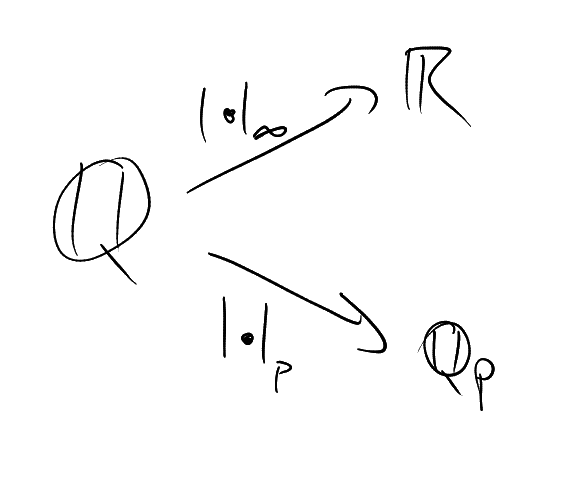1 Absolute values
Definition 1.1 (Absolute value).
Let
be a field. An absolute value on
is a function
such that
-
(i)
if and only if .
-
(ii)
for all .
-
(iii)
(triangly inequality).
We say
is a valued field.
Example.
-
with usual absolute value .
Write
for this absolute value.
-
any field. The trivial absolute value is
Although this is technically an absolute value, it is not useful or interesting, so should be ignored.
Definition 1.2 (-adic absolute value).
Let , and
be a prime.
For ,
write ,
where ,
. The
-adic
absolute value is defined to be
Verification:
-
(i)
Clear
-
(ii)
Write .
Then
|
|
-
(iii)
Without loss of generality, .
Then
|
|
An absolute value
on induces
a metric on
, hence a
topology on .
Definition 1.3 (Place).
Let ,
be absolute values on a field .
We say
and
are equivalent if they induce the same topology. An equivalence class of absolute values is called a
place.
Proposition 1.4.
Assuming that:
Then the following are equivalent:
-
(i)
and
are equivalent.
-
(ii)
for all .
-
(iii)
There exists
such that
for all .
Proof.
-
(i) (ii)
-
(ii) (iii)
Note: . Let
such that
(exists since
is non-trivial).
We need that ,
|
|
Assume that
|
|
Choose
(with )
such that
|
|
Then we have
Hence
and ,
contradiction. Similarly for the case where
|
|
-
(iii) (i)
Clear.
□
Remark.
on is
not an absolute value by our definition. Some authors replace the triangle inequality by
for some fixed .
Definition 1.5 (Non-archimedean).
An absolute value
on
is said
to be non-archimedean if it satisfies the ultrametric inequality:
If
is not non-archimedean, then it is archimedean.
Lemma 1.6.
Assuming that:
Proof.
and
|
|
□
Proposition 1.7.
Assuming that:
Then is Cauchy. In
particular, if is in
addition complete, then
converges.
Proof.
For ,
choose such
that for
. Then
,
|
|
The “In particular” is clear. □
Example.
,
construct sequence
in such
that
-
(i)
-
(ii)
Take . Suppose we
have constructed .
Let and
set .
Then
We choose such
that . Then we
have . Now (ii)
implies that is
Cauchy. Suppose .
Then . But (i)
tells us that , so
, a contradiction.
Thus is
not complete.
Definition 1.8.
The -adic
numbers
is the completion of
with respect to .
Analogy with :
Notation.
As is usual when working with metric spaces, we will be using the notation:
Lemma 1.9.
Assuming that:
Then
-
(i)
If ,
then
– so open balls don’t have a centre.
-
(ii)
If
then .
-
(iii)
is closed.
-
(iv)
is open.
